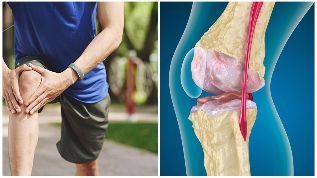
What is osteoarthritis? Types of osteoarthritis
Arthrosis(deforming osteoarthritis, popular name - salt deposition) is a chronic disease of the joints of a degenerative-dystrophic nature, in which the destruction of the articular cartilage, the joint capsule and the deformation of the bone itself occurs.
It should be noted that osteoarthritis is a whole group of joint diseases with different origins and similar development mechanisms. The most common osteoarthritis of large joints:
- Deformant arthrosis of the knee joint (gonarthrosis),
- deforming osteoarthritis of the hip joint (coxarthrosis),
- and shoulder arthrosis.
These are the most severe types of osteoarthritis.
Arthritis of small joints is less common. Deforming arthroses of the interphalangeal joints of the hands are more common. Patients note pain in the interphalangeal joints, a decrease in their mobility, the appearance near the joints of the seals. This type of osteoarthritis is more common in old age. Arthrosis of the ankles is not uncommon.
Generalized osteoarthritis, characterized by simultaneous damage to several joints.
Arthrosis of the spinal joints - spondyloarthrosis - belongs to the group of diseases of the spine, although its development mechanism is similar to that of other arthrosis.
The main clinical symptom of osteoarthritis is joint pain and limited mobility. Specific symptoms are determined by the stage of osteoarthritis and depend on the degree of destructive changes in the joint.
causes of osteoarthritis
Osteoarthritis is usually divided into primary and secondary. Primary (idiopathic) osteoarthritis is a consequence of a disruption in the processes of recovery and increased degeneration of the cartilage tissue of the joint without abnormalities in the work of the whole organism. Secondary osteoarthritis occurs as a result of other pathological processes in the body or in a joint that has already been damaged by external influences, with the joint surfaces being partially destroyed.
Mechanism of osteoarthritis development
The development of osteoarthritis begins with the destruction of the cartilage. The result is pain and crunching when moving. The width of the joint space gradually decreases, bone spikes-osteophytes are formed along the edges of the articular surfaces.
Ultimately, the joint is deformed, the range of motion in it decreases. Osteoarthritis develops in connection with the aging of the body. This form of osteoarthritis usually develops gradually over many years.
There are 3 degrees of arthrosis:
- I degree of osteoarthritis - the disease does not impair work performance, although it complicates it,
- II degree of osteoarthritis - the disease impairs work performance,
- III degree of osteoarthritis - disability.
In the initial stage of the disease, in the morning, after rest, there is stiffness, difficulty moving in the joints, which gradually disappears some time after the movement has started.
As the osteoarthritis develops, the pain becomes more significant and acute.
3rd degree osteoarthritis is a severe, advanced stage of the disease. At this stage the following is observed:
- significant joint deformity
- severe movement restriction,
- sharp pain not only when moving, but also when in a state of complete rest,
- joint inflammation,
- Joint sensitivity to weather changes.
Grade 4 osteoarthritis is a condition of complete destruction of the joint with osteoarthritis when the joint stops working completely. There is a so-called "joint blockage" - acute pain syndrome.
Arthritis treatment
Treatment of osteoarthritis in the early stages of the disease - as early as possible.
At this stage, drugs that improve the structure of cartilage tissue, as well as vitamin and mineral complexes, physical therapy exercises, proper nutrition and preventive measures are useful.
Treatment of arthrosis grade 2 - 3:
- Pain relief or reduction
- Removal of inflammation in the joint.
Treatment of 4th degree osteoarthritis:
Operation and replacement of a diseased joint with an endoprosthesis.
Preventive measures:
Movement is the most important weapon against osteoarthritis. This includes different types of running, swimming, walking. This is a great way to reduce excess weight, which is the enemy of the joints and the whole body.
All joints cannot tolerate the cold. The knees react particularly sharply to this. The use of special knee pads (preferably made from dog hair) can keep the joints warm. A diet for the prevention of osteoarthritis is of great importance: preferably fromRemove foods that are high in fat.
Lean meats, seafood, vegetables, fruits, and steamed foods should be regular meals. It is very important to control your weight. The extra pounds put strain on the thighs and knees. We have to try to prevent falls and bruises.
A good daily routine can be very helpful in preventing osteoarthritis of the shoulder and other joints:
- get enough sleep;
- balanced diet;
- frequent walks in the fresh air;
- positive emotional background;
- love of life and oneself;
General guidelines:
- The heels of the shoes should be comfortable.
- do not sit cross-legged;
- If the day turned out to be difficult, the exercise "bicycle" helps to relieve static loads on the joints;
- relieves joint fatigue water aerobics very well;
Only frequent, correct prevention can prevent the development of osteoarthritis. Cheers.





































